Letterbox Marketing Is King Reach Your Target Audience With Letterbox Marketing. Reach Your Target Audience With Letterbox Marketing
WHAT IS LETTERBOX MARKETING?
Perhaps it’s because of the tactile nature of the items that residents find in their letterboxes, the second-to none deals found within those marketing materials or the quiet, uninterrupted time that shoppers enjoy whilst scanning their favourite weekly catalogues. No matter the reason, Australian consumers are heavily influenced by Letterbox Marketing.
With the ability to target specific, localised audiences or 20.1 million Australians (according to the Australasian Catalogue Association’s Annual Industry Report), every week, a Letterbox Marketing campaign is a powerful and proven channel. Salmat alone reaches 17 million Australians twice a week.
Whether it’s a flyer, catalogue or a sample, Letterbox Marketing gets a brand in front of consumers and helps drive sales. Businesses are able to reach their target audience — big or small — via Letterbox Marketing and related digital channels such as Lasoo.com.au.
COG Print covers everything there is to know about Letterbox Marketing — what it delivers on and how it stacks up against other channels. The information and recommendations can be applied across a wide range of industries such as retail, travel, real estate, healthcare and many more.
Delivering Results With Letterbox Marketing
Letterbox Marketing, when done right, is a direct route into the homes, hands and hearts of current and potential customers.
In the world of marketing, physical catalogues delivered to letterboxes have remained remarkably constant in their ability to drive powerful results, including message delivery, call to action and consumer engagement. But with momentous digital change and the relentless speed at which industries evolve, one would think that Letterbox Marketing needs to do more to be seen and heard by as many of the right eyes and ears as possible. Research shows that even though we’re in an environment where marketing channels are more numerous and fragmented than before, Letterbox Marketing’s dominance remains remarkable.
GREAT VALUE, GREAT REACH
Consider these figures from the Roy Morgan Single Source Australia study:
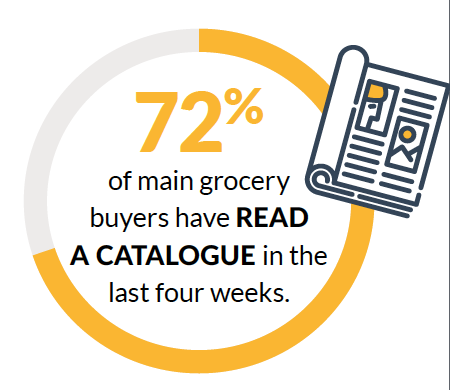
6.8 million Australians, over the age of 14, have PURCHASED FROM A CATALOGUE within seven days of receiving Letterbox Marketing material.
Two in three people, aged between 18 and 49 years old, have READ A CATALOGUE in the past four weeks.
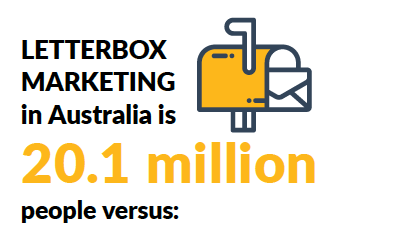
MAGAZINES 12.5 million
NEWSPAPERS 16.8 million
COMMERCIAL RADIO 18 million
FREE-TO-AIR TELEVISION 14 million
SUBSCRIPTION TV 3 million
LETTERBOX MARKETING FOR SMALL, TARGETED CAMPAIGNS
Letterbox Marketing can be utilised in a powerful way for small targeted campaigns, down to 200 houses in a local area. For example, for a small-to medium-sized pharmacy group with 10 locations across Australia, mass advertising may not be a good option as very few customers are going to drive past several other pharmacies in order to visit them.
But, if the pharmacy targets customers with good, local deals, the chances of walk-in rates increase. In that case, the reach of a Letterbox Marketing campaign is tailored to the individual pharmacy locations. It might be anything from a couple of hundred to a few thousand houses in a catchment area that could cover a two to three kilometre radius around the pharmacy itself.
A targeted, local Letterbox Marketing campaign works for a range of businesses such as auto repair shops, hairdressers, jewellery stores, or any business that relies mainly on local custom. And it needn’t be a catalogue. COG Print dropped a postcard in specific areas around Sydney’s eastern suburbs to announce the opening of a new, high-end fashion store. Targeting local areas is one way to reach a market. Another is by specific addresses, from a database, or street by street (see case study on a local NBN rollout — page 10).
COG Print can narrow down an audience by using around 15,000 different lines of data, from census variables to household spend on various products and services, to a household’s similarity to an existing customer demographic. It might be a case of identifying those who are thinking of going on a holiday, or people considering purchasing a house, or are interested in health and fitness. The amount of data that is readily available is enormous.
COG Print can target people who have purchased from a particular retailer in the past four weeks, or those who are interested in purchasing products for babies. COG Print clients can do this and much more using an online, data rich, media scheduling tool. Plot the location of a store or business and we will show how many letterboxes are within specific distances, or driving times. It will also indicate the budget required to conduct a Letterbox Marketing campaign to these households. The user can then overlay numerous other data and demographic options (eg: people who use gyms, travel internationally, specific age groups) to accurately plot a campaign. This data can also be used to create a profile and find like-for-like customers within a particular area.
Typically, the more targeted a campaign becomes via some other media channels such as paid search and paid social, the more expensive it becomes. In order to be hyper targeted through such digital channels, it likely requires the purchase of third-party data, or a deal involving second-party data from another provider; there is always an associated cost. But a small Letterbox Marketing campaign can be more cost effective. The cost per piece might be slightly higher in a small Letterbox Marketing campaign compared to a large one, but the increase is small compared to some other channels.
CASE STUDY – A LOCAL NBN ROLLOUT
When the NBN rollout was taking place on Queensland’s Sunshine Coast, three Telstra licensed stores were promoting its availability among local households. They developed a Letterbox Marketing campaign to assist with this initiative. A flyer encouraged householders to complete a form on the back of the flyer, or send a text code to a specific number. Once potential customers did so, they were entered into a draw to win $2000 of travel money. Letterbox Marketing drops were highly localised and followed the rollout of the NBN, which was a street-by-street rather than suburb-by-suburb approach. Over the entire period of the rollout, 15,000 flyers were delivered. The Letterbox Marketing campaign proved to be more successful than any other marketing channels used during the rollout as it eliminated non-profitable interactions with customers outside the rollout zone and returned a measurable and profitable result — a three to one ROI.
GOING BIG! At the other end of the spectrum is Letterbox Marketing’s ability to communicate across Australia. COG Print alone can reach 17 million Australians twice every week. It’s a claim that no other form of marketing can make. Letterbox Marketing covers more Australians than social media, television, radio or newspapers. A Roy Morgan study revealed that, of 10.8 million Australians who have read unaddressed mail in the past week
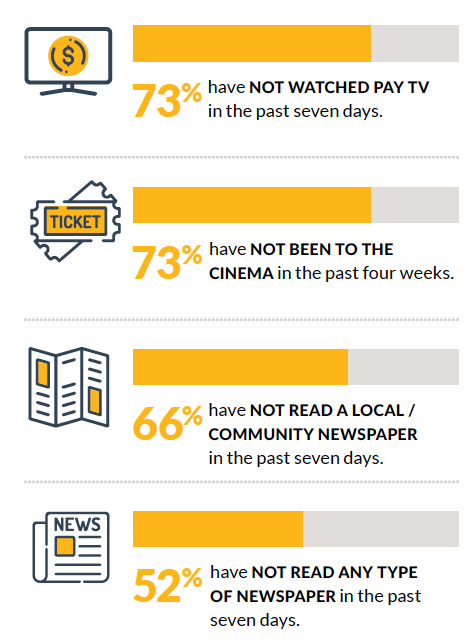
That same research revealed that of all paid marketing channels, Australians consider catalogues to be the second most useful media for providing information.
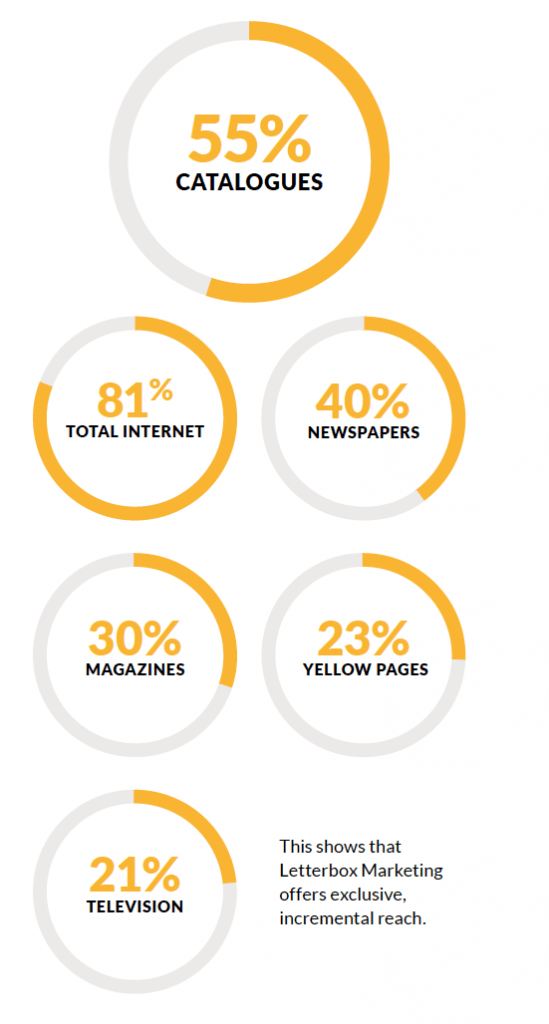
CREATING A POSITIVE CATALOGUE EXPERIENCE
People are bombarded with thousands of pieces of information every day, mostly marketing pieces that arrive at a given time chosen by the marketer not the customer. Most channels, as a result, may seem cluttered and annoying to many, rather than simple and welcoming. But Letterbox Marketing is one of the only mediums left that is almost entirely opt-in. It’s unobtrusive and allows consumers to choose to engage at a time that suits them. Perhaps this explains why Australians consider catalogues to be the first or second ‘media most useful’ across 15 major product categories including groceries, toys, cosmetics and toiletries, and fashion.
Catalogues and other Letterbox Marketing collateral are typically read when the consumer has a moment of peace, some downtime in which they can relax and read through something that actually interests them. It might be about working out the family’s grocery shopping for the week, a search for inspiration around furniture, white goods or car accessories, or just a stickybeak to find out what ALDI has coming up on sale.
Of course, this means that the consumer is in a more positive frame of mind when they engage with Letterbox Marketing collateral — it’s not interrupting a TV show, popping up uninvited in an email inbox or clogging up a social media feed.
PROVING THE POWER OF LETTERBOX MARKETING
The Australasian Catalogue Association’s Industry Report shows the value of Letterbox Marketing on the path to purchase:
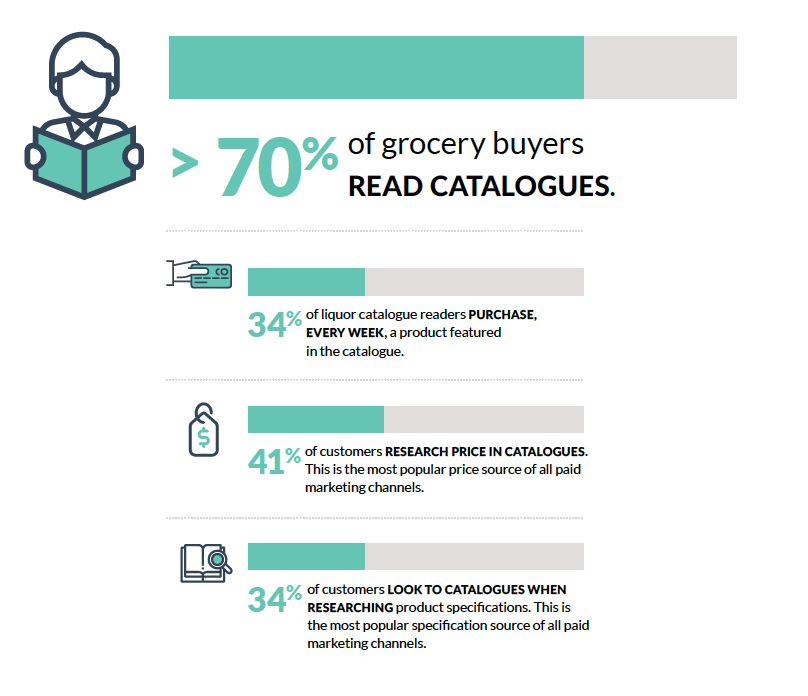
MAKING EVERY DELIVERY COUNT
But how do deliveries actually happen? When a business pays for a Letterbox Marketing campaign to be delivered to letterboxes of hundreds, thousands or millions of Australians, how does that business know the deliveries have occurred? To track success of a delivery, and to offset such concerns, COG Print offers internal audits as well as external, third-party auditing. In order to carry out the internal audit, COG Print uses GPS verification. As the distributor travels up and down streets to deliver catalogues, their movements are plotted on a map and sent to COG Print once the walk is complete. Only when the GPS points confirm the movements and the distributor themselves validate their deliveries via a custom-built app, COG Print, are the sections marked off as complete.
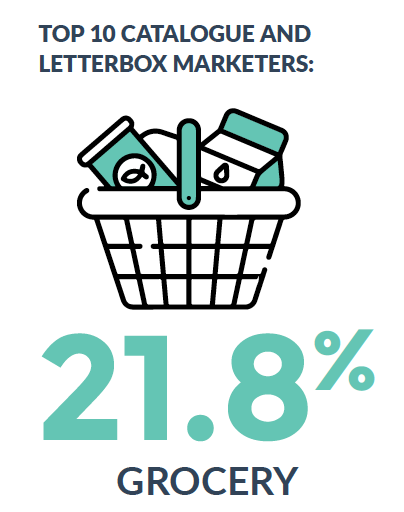
 COG Print also acts as an exclusive communication tool with all distributors. They use it to be informed of and accept jobs. It can be used to guide their delivery routes, and if a group is working together on a route, they will have the app on each of their phones so that the completed jobs and their GPS coordinates can be sent back.
COG Print also acts as an exclusive communication tool with all distributors. They use it to be informed of and accept jobs. It can be used to guide their delivery routes, and if a group is working together on a route, they will have the app on each of their phones so that the completed jobs and their GPS coordinates can be sent back.
On top of this, a third-party verification process is conducted, meaning an independent auditor conducts an investigation across a random sample of the delivery region. They check that people in that area recall seeing specific catalogues in the last week or so by speaking with members of the households who’d be most interested in specific brands and product categories. This audit is conducted every month, all year long, to ensure external findings match internal ones across the entire country. These checks are included as part of the distribution service to clients.
THE RETURN ON INVESTMENT
Some retailers measure the increase in foot traffic, or the rise in people entering a store (both during and soon after a campaign). Perhaps, there was a 25% increase in foot traffic, and therefore the retailer now has a benchmark against which it can measure the success of its ongoing Letterbox Marketing campaigns. Another method of identifying ROI is to analyse the increase in web traffic, particularly if the catalogue contains a specific offer requiring the entry of a code at checkout, for instance.
Google Analytics is a tool that can be utilised to measure the increase in search traffic during a campaign. All of these methods measure the driving of value back to the business that is utilising Letterbox Marketing, and not only through increased sales revenue and foot traffic. The most measurable is a direct call to action. This will enable a business to track all the way through to purchase, whether it’s an in-store redemption of a voucher or an application for something specific, such as a loyalty club membership or the registration of an email to receive news of special deals, new product availability, etc. Value is measured in a number of ways, depending on what a retailer wants to get out of a campaign.
So, what does success look like? Letterbox Marketing is not like radio, which measures its success only in market share. According to market share alone, COG Print has 95% share of letterboxes in Australia. This figure reflects the ‘pure reach’ that Letterbox Marketing enables. Return on investment is about much more than that, and it is very much related to the goals of the brand that is running the campaign.COG Print works with its clients to understand their campaign goals and builds a measurable, data-driven, targeted campaign to help them achieve those goals. Major supermarkets, for instance, know how much they make from every catalogue campaign and how to fine-tune each campaign for a particular purpose. They measure values and ROI, and they know their catalogues are one of their best drivers of ROI. But mid-tier businesses don’t necessarily have that sophistication. In that case, data points around value are crucial. ForCOG Print, it’s about connecting client goals, collecting data around those goals, then reporting back to clients.
CASE STUDY A TOTAL TRANSFORMATION
Baby Bunting employs about 700 people across 36 superstores. But three years ago, the brand found its revenue falling as market share was eaten away by competitors. The company made a decision to become more targeted in its catalogue distribution, reinvigorating its catalogues and optimising its campaign to focus solely on mums as a target audience.
Success was measured in revenue, with a goal of winning back market share and bringing revenue back up to where it was before the slump. Catalogue distribution numbers increased, with a focus on its new target market. Store and demographic data were combined to identify pockets of potential customers who had previously not received its catalogues.
Baby Bunting also put its catalogues on Lasoo.com.au, since the re-launch of their catalogue strategy, Baby Bunting have achieved its goals by returning to its previous state of sales. At the same time, Baby Bunting has increased digital presence with more than two million catalogue opens and 355 million impressions via Lasoo.
TARGETING CAMPAIGNS
Pretty much anything that fits into a letterbox can be used in a campaign. The options are limitless and businesses are beginning to explore the possibilities. One opportunity is targeting on a postcode level. Some supermarkets and other businesses are already doing this effectively.
For example, a major alcohol retailer has a store in a region where people have an interest in microbreweries and craft beer. That particular neighbourhood’s bottle shop offers local craft beers and ciders. Management knows the community is interested in local produce. This alcohol retailer has addressed this by customising some of the brand’s catalogue campaigns to include local boutique beers. This type of targeting is working well, as opposed to simply assuming that one size fits all and sending every household in a region the same catalogue. Within a state itself such as NSW for example, people in Newcastle might receive a different version of a catalogue to the people in Neutral Bay, and that might be different to the catalogue that people in Wollongong receive.
A targeted demographic in a particular area means the catalogue can be shaped to target tastes and interests of the local population. There is also another type of targeting. As opposed to known specific interests, it has more to do with a propensity to be interested in a particular purchase. People with young children may tend to congregate in a particular area. Families from specific cultures might live in close proximity. And those interested in particular sports or pastimes, fitness or health programs might all be attracted to a region or area. Utilising data to learn about the types of people in a local area also helps retailers and businesses better target their messaging.
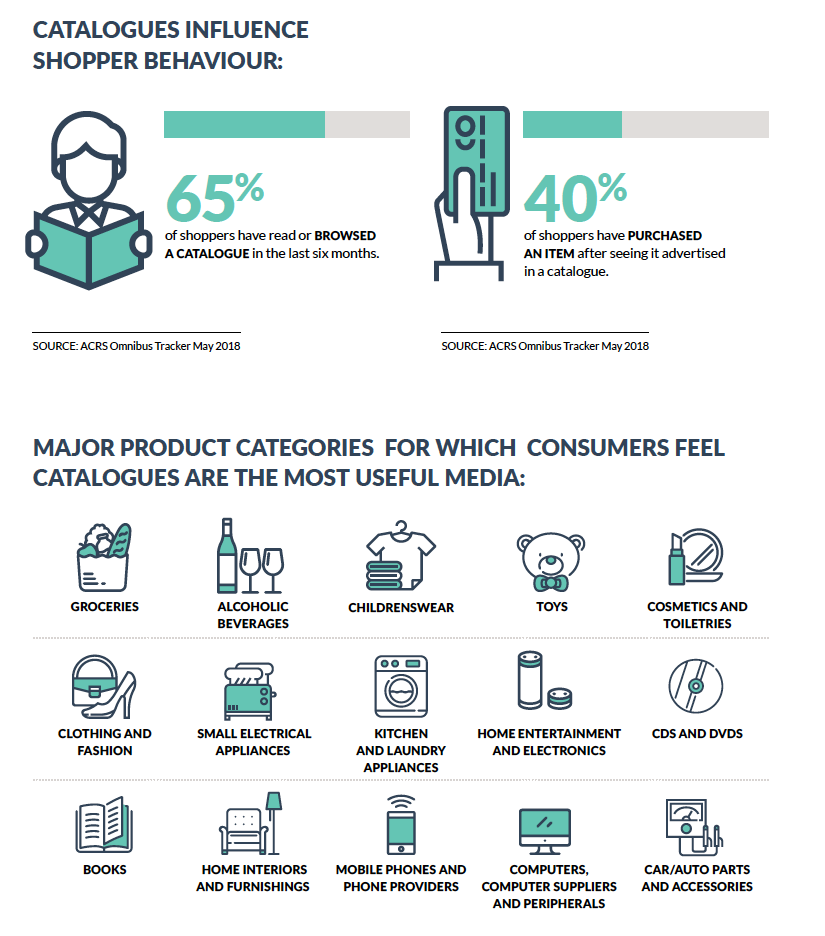
IT’S NOT ALL ABOUT CATALOGUES
Letterbox Marketing is about anything that goes into a letterbox, not just catalogues. COG Print delivers the Materials In The Raw brand book, for instance, which weighs 340 grams per book. Samples are also an extremely effective Letterbox Marketing strategy in a campaign that is easy for a brand to measure.
For example, COG Print has delivered dishwashing tablets — two tablets shrink-wrapped, with a flyer and a special offer inside. Recipients used the tablets, registered online to activate the special offer, then visited their local supermarket and purchased the product at a discount. This type of promotion can be carried out in specific regions or catchment areas around a particular store, allowing the brand to conduct an A/B test against areas that are not running the campaign.
Scent-based flyers is another option. For example, to promote a clothes washing detergent, a flyer can smell like freshly washed clothing. COG Print has produced this for a client, delivering a ‘freshly washed’ scent before the householder even opened their letterboxes. This led to an impressive increase in sales. Many different elements of a single campaign are valuable to the business that is utilising the Letterbox Marketing platform, including collection of email contacts, increased sales revenue and foot traffic from the campaign itself, and the analytics that come after the promotion has run, allowing the brand to continue to improve ongoing campaign performance.
Researchers are only just beginning to understand the emotional power of touch, or ‘somatosensation’. Different fabrics, for example, have been proven to elicit different brain responses related to pleasure. Silk might make the recipient think of luxury and class, while terry towelling might elicit comfort and cleanliness.
Shape is another factor that can be considered — collateral in the shape of a car for a car dealer or the shape of a ring for a jewellery store, or a coffee-cup shaped fridge magnet from the local café, for instance.
Letterbox Marketing is the only channel, outside a retail store itself, that can boast touch (and smell) as an influencer of purchase decision. Tea bag samples have gone into Letterbox Marketing campaigns, as have skincare products and cosmetics samples.
Similarly, high-end fashion brands and fashion retailers have conducted very effective ‘look book’ campaigns, delivering a high quality fashion publication that inspires style choices for new seasons. So, Letterbox Marketing campaigns are restricted only by the size of the letterbox and the imagination of the marketer. How can a brand surprise and delight its customers through Letterbox Marketing?
AREN’T AUSTRALIANS MORE INTERESTED IN TECHNOLOGY?
Where does Letterbox Marketing fit into a culture famous for its early adoption of technology?
Today’s competitive trading environment has seen businesses giving much more emphasis to online as a medium to effectively communicate with customers. And when Australians are all about smartphones and tablets, and are busy digesting information via digital channels, Letterbox Marketing may seem to be a little bit old-school.
Actually, statistics tell a different story. According to the Australasian Catalogue Association, 58% of Australians aged 25 to 34 read catalogues and 93% of Australians go into a store after reading a catalogue.
Research revealed that price is still the strongest driver of a purchase decision — 83% of shoppers say that purchases are driven mainly by price. In addition, 65% of shoppers say they will switch brands if a product is on sale or if there is another incentive to purchase. Match these figures up to the fact that Australians expect the very sharpest deals to come to them via Letterbox Marketing, and it becomes clear why Letterbox Marketing is still one of the most powerful forces in the modern-day marketing mix.
Today, there are more consumers reading catalogues in Australia than at any other given time. Around seven million Australians read supermarket catalogues on a weekly basis, for instance. And digital has become an important part of the successful marketing mix as Australians love their technology. But when such a large percentage of shoppers voluntarily choose, to flick through a physical catalogue whilst relaxing with a cup of tea, Letterbox Marketing becomes a difficult medium to beat.
Letterbox Marketing is also a great leveller for businesses of all shapes and sizes. Using Letterbox Marketing, a local retailer can rub shoulders with supermarket giants and receive the same level of attention enjoyed by the nation’s biggest retail businesses. These smaller players have smaller marketing budgets and often don’t have the expertise to manage all of the various options required for an effective online campaign, but Letterbox Marketing hits a targeted market and is guaranteed to deliver.
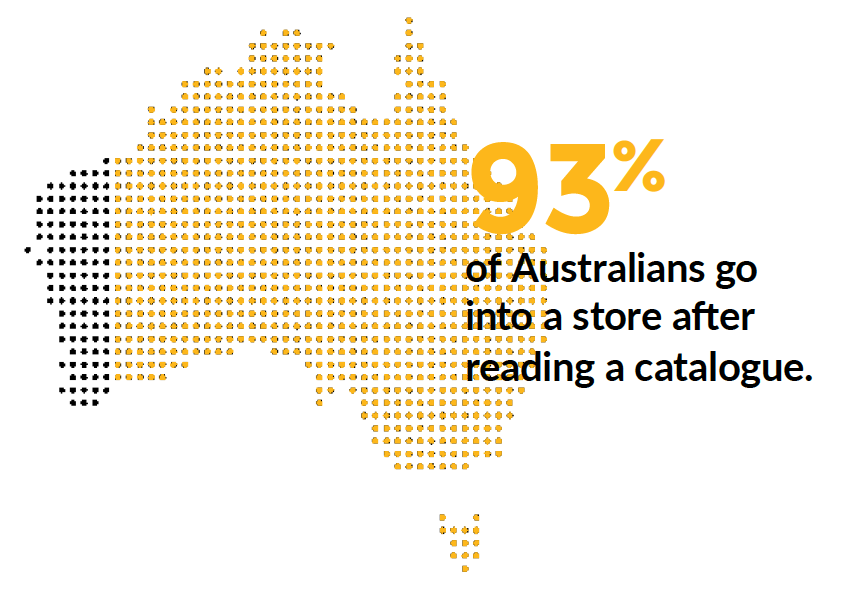
COMBINING LETTERBOX MARKETING WITH DIGITAL
COG Print was built on Letterbox Marketing, but in today’s business environment every industry has something to gain from data. So COG Print has combined Letterbox Marketing with digital channels, to powerful effect. The combination of physical Letterbox Marketing and online catalogue distribution creates enormous opportunities for retailers and businesses looking to drive greater reach, improve ROI, fine tune sales promotions and increase exposure.

